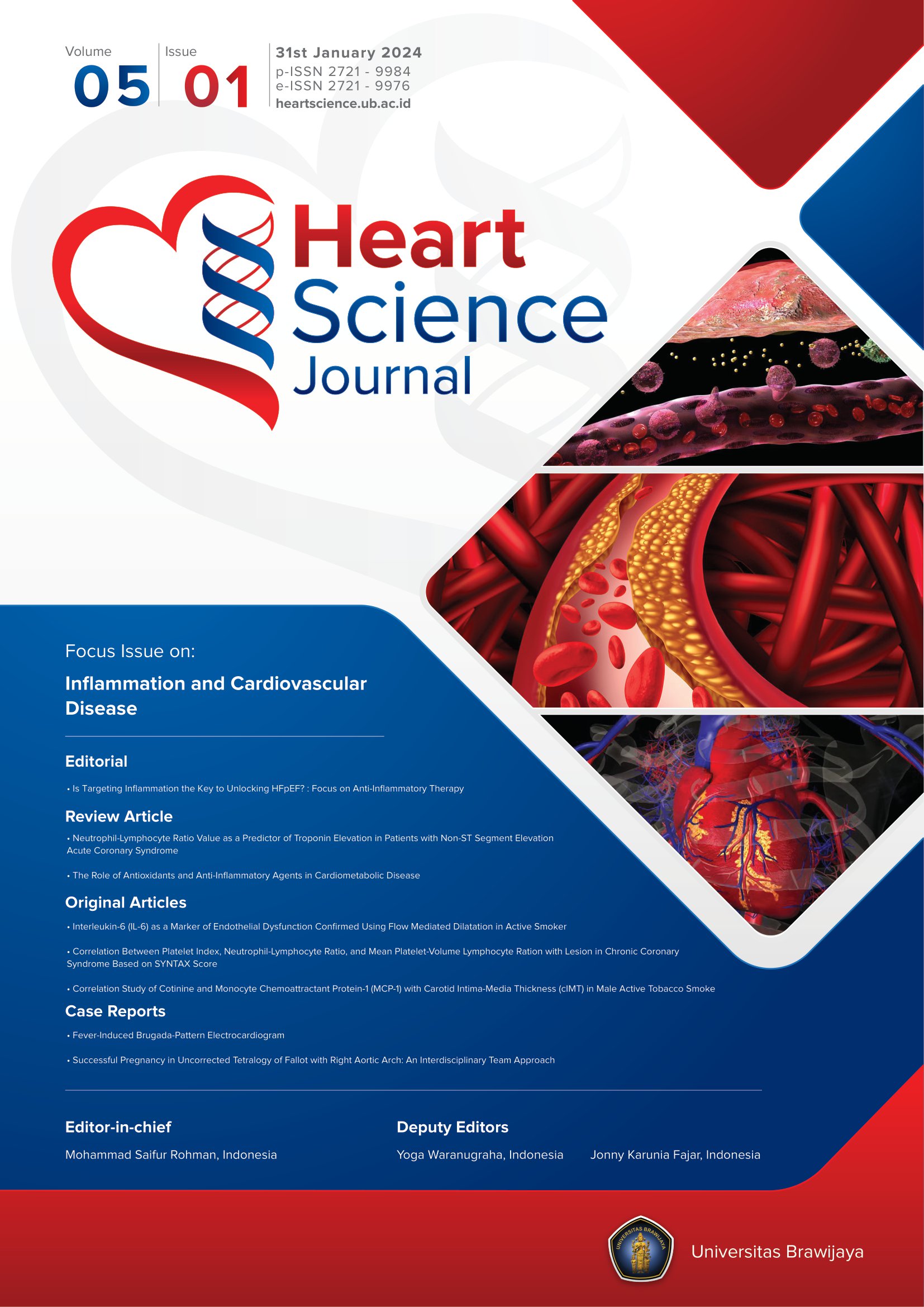Symptomatic Bradycardia In CAD Patient: Which One First To Treat?
Abstract
Background: The incidence of sinus node dysfunction (SND) increases with age. Likewise, the incidence of coronary artery disease (CAD) has increased from year to year in Indonesia. When doctors are faced SND patients with CAD, it can be confusing in determining initial treatment options.
Objective: This study aimed to describe the diagnosis and management of SND in CAD patient.
Case Presentation: We will discuss a 75 years old male who had schedule to management of bradycardia symptomatic related to SND. Five month before admission, he had acute coronary syndrome, and had 2 DES implantation at left main (LM) to proximal left anterior descendent (LAD) artery and mid LAD. Two month after PCI he felt near syncope with bradycardia. Evaluation with ambulatory EKG was performed with result of SND, and correction of reversible cause related to SND already done. Eventually, symptom still exist and PPM insertion was decided to perform.
Conclusion: Patients with SND and CAD have a higher risk of complications and death. Correction of reversible factors, one of which is CAD, can be done as an initial step in the treatment of SND. When symptomatic signs still appear after correction of reversible causes, PPM implantation is the modality of choice in management.
Keywords
Full Text:
PDFReferences
Kusumoto, F. M. et al. 2018 ACC/AHA/HRS Guideline on the Evaluation and Management of Patients With Bradycardia and Cardiac Conduction Delay: A Report of the American College of Cardiology/American Heart Association Task Force on Clinical Practice Guidelines and the Heart Rhyth. J. Am. Coll. Cardiol. 74, e51–e156 (2019).
Zipes, D. P., Libby, P. & Bonow, R. O. Braunwald’s Heart Disease A Textbook of Cardiovascular Medicine, Eleventh Edition. (Elsevier Inc., 2019).
Choudhury, M., Boyett, M. R. & Morris, G. M. Biology of the sinus node and its disease. Arrhythmia Electrophysiol. Rev. 4, 28–34 (2015).
Jensen, P. N. et al. Incidence of and risk factors for sick sinus syndrome in the general population. J. Am. Coll. Cardiol. 64, 531–538 (2014).
Kemenkes RI. Situasi kesehatan jantung. Pus. data dan Inf. Kementeri. Kesehat. RI 3 (2014) doi:10.1017/CBO9781107415324.004.
Kemenkes RI. Laporan_Nasional_RKD2018_FINAL.pdf. Badan Penelitian dan Pengembangan Kesehatan 198 (2018).
National, G. & Pillars, H. Statistik Penduduk Lanjut Usia. (Badan Pusat Statistik, 2020).
Bodin, A. et al. Ischemic Stroke in Patients with Sinus Node Disease, Atrial Fibrillation, and Other Cardiac Conditions. Stroke 1674–1681 (2020) doi:10.1161/STROKEAHA.120.029048.
Alonso, A. et al. Association of sick sinus syndrome with incident cardiovascular disease and mortality: The atherosclerosis risk in communities study and cardiovascular health study. PLoS One 9, (2014).
Achyar et al. Panduan Kursus Bantuan Hidup Jantung Lanjut. (2021).
Brignole, M. et al. 2018 ESC Guidelines for the diagnosis and management of syncope. Eur. Heart J. 39, 1883–1948 (2018).
Mangrum, J. M. & DiMarco, J. P. The Evaluation and Management of Bradycardia. N. Engl. J. Med. 342, 703–709 (2000).
Glikson, M. et al. 2021 ESC Guidelines on cardiac pacing and cardiac resynchronization therapy. Eur. Heart J. 42, 3427–3520 (2021).
Yuniadi, Y., Hanafy, D. A., Rizal, A., Haryadi & Hermanto, D. Y. Kapita Selekta Aritmia. Pengetahuan Praktis untuk Kardiolog dan Residen. (Sagung Seto, 2018).
Zimetbaum, P. & Goldman, A. Ambulatory arrhythmia monitoring: Choosing the right device. Circulation 122, 1629–1636 (2010).
Abbott, A. V. Diagnostic approach to palpitations. Am. Fam. Physician 71, 743–750 (2005).
Sathnur, N., Ebin, E. & Benditt, D. G. Sinus Node Dysfunction. Card. Electrophysiol. Clin. 13, 641–659 (2021).
Menozzi, C. et al. The natural course of untreated sick sinus syndrome and identification of the variables predictive of unfavorable outcome. Am. J. Cardiol. 82, 1205–1209 (1998).
Opie, Lionel H; Gersh, B. J. Drugs for The Heart. (Elsevier Saunders, 2013).
Engel, T. R., Meister, S. G., Feitosa, G. S., Fischer, H. A. & Frankl, W. S. Appraisal of sinus node artery disease. Circulation 52, 286–291 (1975).
Goldstein, J. A., Lee, D. T., Pica, M. C., Dixon, S. R. & O’Neill, W. W. Patterns of coronary compromise leading to bradyarrhythmias and hypotension in inferior myocardial infarction. Coron. Artery Dis. 16, 265–274 (2005).
Serrano, C. V. et al. Sinus bradycardia as a predictor of right coronary artery occlusion in patients with inferior myocardial infarction. Int. J. Cardiol. 68, 75–82 (1999).
Goldstein, J. A., Barzilai, B., Rosamond, T. L., Eisenberg, P. R. & Jaffe, A. S. Determinants of hemodynamic compromise with severe right ventricular infarction. Circulation 82, 359–368 (1990).
Yuniadi, Y. Forum Aritmia Sindrom Bradi-Takiaritmia. J. Kardiol. Indones. 34, 292–294 (2013).
DOI: https://doi.org/10.21776/ub.hsj.2022.003.04.6
Refbacks
- There are currently no refbacks.
Copyright (c) 2022 Aloysius Yuwono Suprapta

This work is licensed under a Creative Commons Attribution 4.0 International License.









